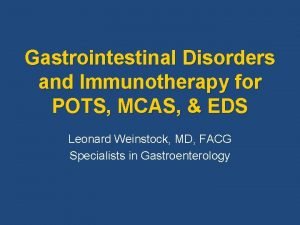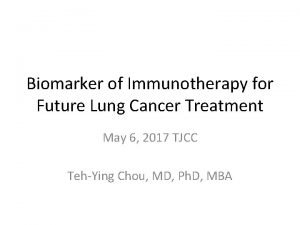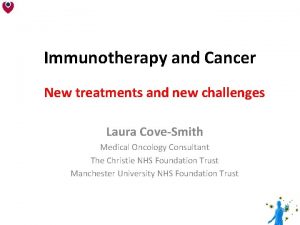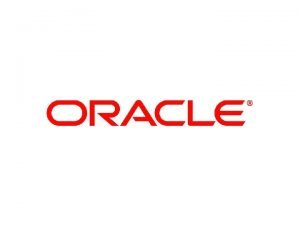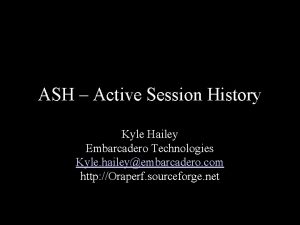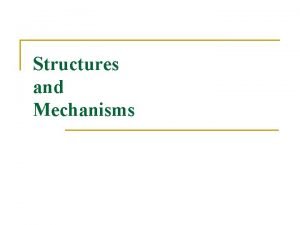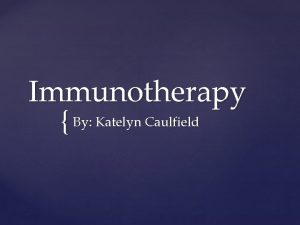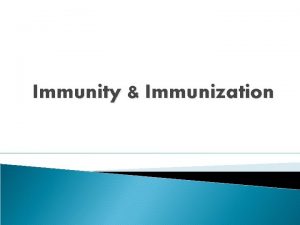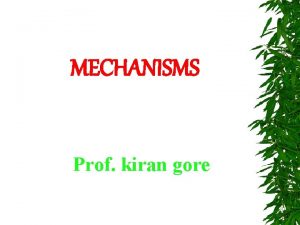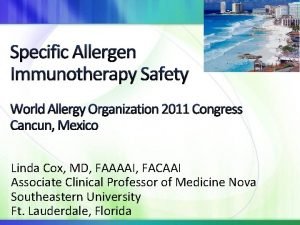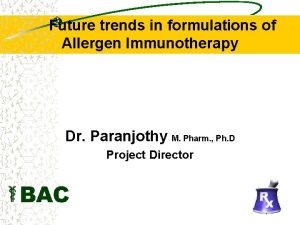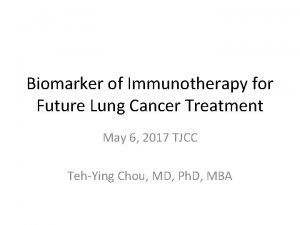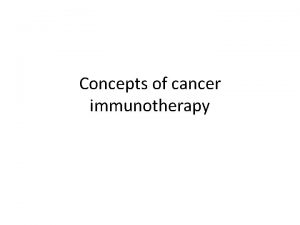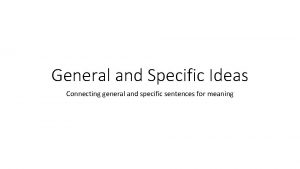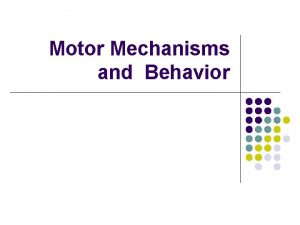SPECIFIC IMMUNOTHERAPY Session 1 History Mechanisms and Future




















- Slides: 20

SPECIFIC IMMUNOTHERAPY Session 1: History, Mechanisms and Future History of SIT 22 nd World Allergy Congress Cancún, Mexico Richard W. Weber, M. D. National Jewish Health Denver, Colorado USA

DISCLOSURES SPEAKERS BUREAUS: ASTRAZENECA, GENENTECH RESEARCH GRANTS: NOVARTIS, GLAXOSMITHKLINE, PFIZER, MERCK ASSOCIATE EDITOR: ANNALS OF ALLERGY, ASTHMA & IMMUNOLOGY ASSOCIATIONS: AAAAI, ACAAI, CAAS NO CONFLICTS OF INTEREST PERTAINING TO SUBJECT MATTER OF THIS TALK

William Dunbar, M. D. Zur Ursache und specifischen Heilung des Heufiebers, München, 1903 Mucous membranes and skin of hay fever sufferers sensitive to pollen not seen in normal individuals Injection of pollen into animals rises neutralizing “antitoxin” Specific precipitation of pollen extracts by patient’s serum Pollen extract prepared by freezing and thawing, followed by ten minutes of boiling, then sealing

Carl Prausnitz (Giles), M. D. • Hamburg, 1904 • 1 st attempt at pollen vaccination administered to Dunbar by Prausnitz • Resulted in violent systemic reaction • Prausnitz-Küstner reaction, 1921 • 1 st successful cutaneous transfer of hypersensitivity • Fish sensitivity transferred from Küstner to Prausnitz • Pollen sensitivity not transferable

Leonard Noon, F. R. C. S. Prophylactic inoculation against hay fever. Lancet June 10, 1911 Believed pollen contained toxin and subcutaneous injection of pollen extract induced production of antitoxin Phleum pratense (timothy grass) extract most potent Sensitivity defined by conjunctival challenge 6 -10 fold decrease in sensitivity could be induced by increasing doses of 3 -6 sub-Q injections

John Freeman, M. D. Further observations on the treatment of hay fever by hypodermic inoculations of pollen vaccine. Lancet Sept 16, 1911 Twenty subjects with >2 preseasonal injections, with final increased strength from 1. 1 to 500 fold higher 15 did well; 3 considered failure, “disappointing” or inconclusive; 1 improved clinically but significant adverse reaction to highest dose; 1 from Canada with autumnal sxs

John Freeman, M. D. Vaccination against hay fever: Report of results during the last three years. Lancet April 25, 1914 84 patients with English hay fever inoculated with Phleum pratense pollen preseasonally 18 in 1911; 25 in 1912; 41 in 1913 30. 1% cured or insignificant sxs; 34. 5% markedly improved; 23. 9% minimal improvement; 11. 5% no better (two patients worse) “Patients with marked constitutional disturbances, including asthma, do better” “Patients with an inherited tendency do better” “Age makes no difference to the benefit derived from treatment”

EARLY CHRONOLOGY OF ALLERGEN IMMUNOTHERAPY 1904 Dunbar & Prausnitz – Pollen “toxin” injections 1911 Noon – Prophylactic inoculations against hayfever 1911 Freeman - Further observations 1930 Freeman - “Rush” inoculations 1932 A Brown – Superiority of perennial over pre-seasonal administration of immunotherapy 1932 -1935 GT Brown – Maximum dosage pollen therapy 1933 Colmes & Rackemann – Skin reactivity changes with immuotherapy

EARLY CHRONOLOGY OF ALLERGEN IMMUNOTHERAPY 1935 Cooke, Barnard, Hebold & Stull - Serologic evidence of immunity 1940 Sherman, Stull & Cooke – Serologic changes in hay-fever with treatment over years 1943 Loveless - Relationship of thermostable antibody & clinical immunity 1948 Alexander, Johnson & Bukantz – Lack of correlation between thermostable antibody titer and degree of clinical protection

“Rush” inoculation, with special reference to hay-fever treatment. Freeman J: Lancet 1930; i: 744 -7. “Leisurely Desensitisation: ” (c. 1909) single injections @ weekly intervals off-season “inoculations were given weekly merely because our outpatients at St. Mary’s were in the habit of coming every week. ” “Intensive Desensitisation: ” (c. 1924) single injections every day with increasing doses (10 -20% increase) Used initially for horse dandruff sensitive asthmatics with success Increasingly adapted to hay-fever patients (c. 1926)

“Rush” inoculation, with special reference to hay-fever treatment. Freeman J: Lancet 1930; i: 744 -7. “Rush Desensitisation: ” (c. 1928) multiple injections q 1. 5 -2 h throughout 14 hour day; completed in 2 -4 days Patient in “hospital or some such institution” – treatment continued through symptoms of urticaria, headache, throat & nasal congestion, and treatment with adrenalin Used in dust asthma, fish allergy, horse dander, hay-fever

“Rush” inoculation, with special reference to hay-fever treatment. Freeman J: Lancet 1930; i: 744 -7. A= good night B= local reaction C= generalized rash D= sneezing E= throat & nasal congestion F= headache & drowsy G= restless night H= generalized rash & eyelid swelling I= adrenalin ? = out of hospital

“Rush” inoculation, with special reference to hayfever treatment. Freeman J: Lancet 1930; i: 744 -7.

“Rush” inoculation, with special reference to hay-fever treatment. Freeman J: Lancet 1930; i: 744 -7. Advantages of the “rush” method Saving of time Convenient scheduling – “one may even wait till the patient is in real distress – always a good time for getting a patient to do what he is told. ” Closer observation of reactions with more expeditious therapy Doses can be more readily adapted

“Rush” inoculation, with special reference to hay-fever treatment. Freeman J: Lancet 1930; i: 744 -7. “In choosing a system of desensitisation, one need not, of course, adhere rigidly to the leisurely, intensive, or “rush” methods; an intelligent blend may serve one’s turn better. ” “The ‘rush’ method of desensitisation offers many advantages when used either alone or in combination with other systems. To get successful and safe results, however, it is just as necessary as ever to be cautious. ”

CLINICAL EFFICIACY OF ALLERGEN IMMUNOTHERAPY DOUBLE-BLIND PLACEBO-CONTROLLED STUDIES Rhinitis Asthma *Northern grasses *Short ragweed *Ragweed Amb a 1 *Mountain cedar *Birch/Alder/Hazel Parietaria Cladosporium Alternaria *Northern grasses *House dust *Ragweed Amb a 1 *Mountain cedar *Birch/Alder/Hazel *D. pteronyssinus Cladosporium Alternaria Dog dander *Cat dander Hymenoptera Allergy *Venom *(1954 -1984)

EARLY CHRONOLOGY OF ALLERGEN IMMUNOTHERAPY 1954 Frankland & Augustin – First DBPC efficacy study with grass hay-fever & asthma 1965 Lowell & Franklin – First DBPC short ragweed hay-fever study 1967 Franklin & Lowell – Dosage comparison in ragweed immunotherapy 1971 Aas – First DBPC house dust asthma study 1976 Pence et al – Mountain cedar rhinitis & asthma study 1978 Warner et al – D. pteronyssinus house dust mite asthma study

Modified from Gleich GJ et al J Allergy Clin Immunol 1982; 70: 261 -71

“Stock” Respiratory Vaccines Hollister-Stier Staphylococcus aureus 6 x 108/cc; Staphylococcus albus 6 x 108/cc; Streptococcus viridans/pyogenes 2 x 108/cc; H. influenzae 1. 5 x 108/cc Danish S. aureus 9 x 107/cc; S. viridans/pyogenes 6 x 107/cc; D. pneumoniae 3 x 108 /cc; H. influenzae 12. 5 x 108/cc; K. pneumoniae 2 x 107 /cc; Neisseria 8 x 107/cc

BACTERIAL VACCINES – Negative DBPC Efficacy Studies Frankland, Hughes, Gorrill, 1955: Autogenous Johnstone, 1959: Autogenous, Stock, or Staphylococcal toxin Aas et al, 1963: Stock vaccine Barr et al, 1964: Stock vaccine
 Initinib
Initinib How to draw a motor bike
How to draw a motor bike Delmovate
Delmovate Exercise future continuous and future perfect
Exercise future continuous and future perfect Future perfect simple vs future perfect continuous
Future perfect simple vs future perfect continuous Weight and density formula
Weight and density formula Pharmaceutical application of specific gravity
Pharmaceutical application of specific gravity Active session history
Active session history Active session history
Active session history Future continuous future perfect exercises
Future continuous future perfect exercises Summary tenses
Summary tenses Future plans and finished future actions
Future plans and finished future actions Future continuous and future perfect
Future continuous and future perfect Kondicional 1 engleski
Kondicional 1 engleski Future perfect
Future perfect Simple present simple past simple future
Simple present simple past simple future Future nurse future midwife
Future nurse future midwife Examples
Examples Present continuous future
Present continuous future Virtualization tools and mechanisms
Virtualization tools and mechanisms Structure and mechanism
Structure and mechanism
